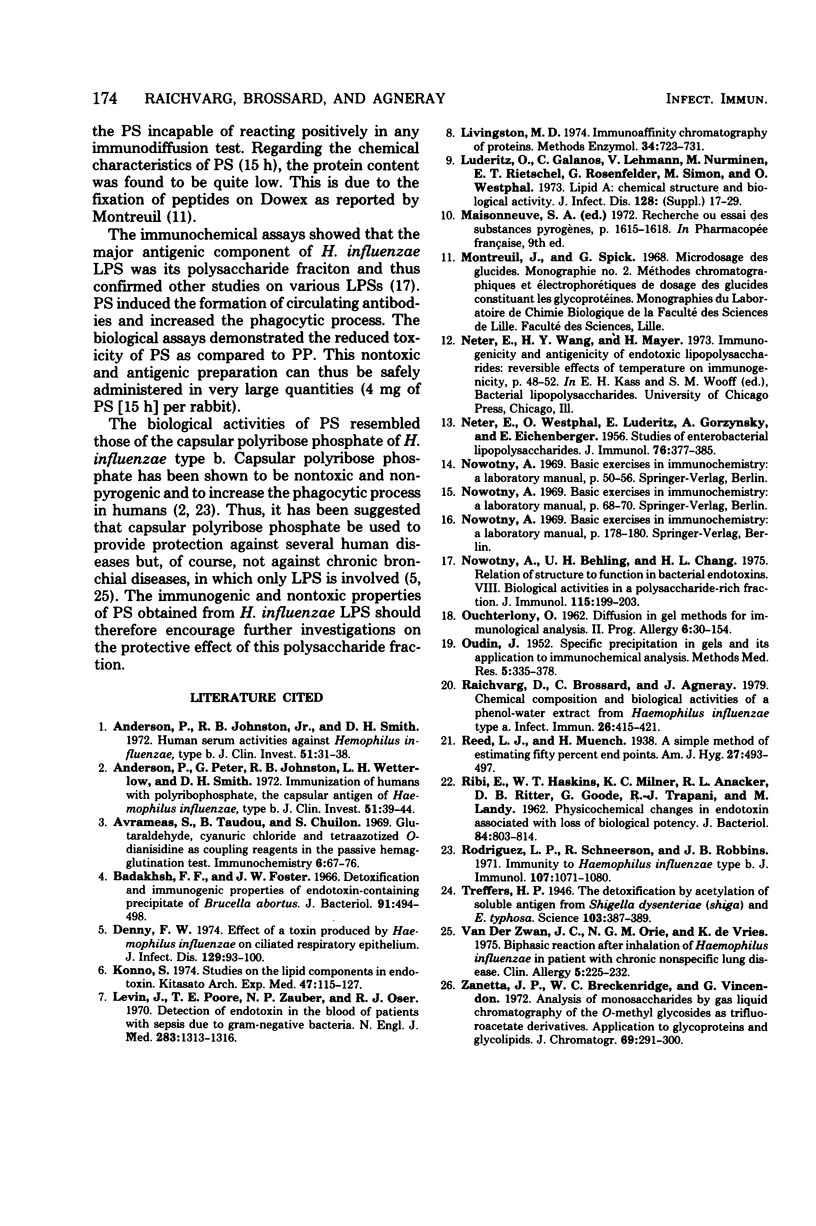Abstract
A phenol-water extract from Haemophilus influenzae type a was hydrolyzed to decrease the toxicity without affecting the antigenicity of the preparation. We used partial hydrolysis for 15 h with ion exchangers in the presence of chloroform. The lipid fraction was collected into the organic solvent. The preparation obtained from the aqueous solution was designated the polysaccharide fraction. Rhamnose, glucose, galactose, mannose, and glucosamine were the major components of the polysaccharide fraction, and their molar ratios were determined by gas-liquid chromatography; 2.5% myristic acid was also found in the polysaccharide fraction. The mild hydrolysis of the polysaccharide fraction for 15 h caused a marked reduction in toxicity (50% lethal dose, 183 +/- 9 microgram/kg) and pyrogenicity. The generalized Sanarelli reaction was negative. The local Shwartzman phenomenon was not observed if chloroform and Dowex were exchanged three times during hydrolysis. Most of the antigenic components remained active after the hydrolytic process. The polysaccharide fraction could also induce the formation of circulating antibodies in rabbits and also increase the phagocytic process against H. influenzae from month 2 to 6.
Full text
PDF



Images in this article
Selected References
These references are in PubMed. This may not be the complete list of references from this article.
- Anderson P., Johnston R. B., Jr, Smith D. H. Human serum activities against Hemophilus influenzae, type b. J Clin Invest. 1972 Jan;51(1):31–38. doi: 10.1172/JCI106793. [DOI] [PMC free article] [PubMed] [Google Scholar]
- Avrameas S., Taudou B., Chuilon S. Glutaraldehyde, cyanuric chloride and tetrazotized O-dianisidine as coupling reagents in the passive hemagglutination test. Immunochemistry. 1969 Jan;6(1):67–76. doi: 10.1016/0019-2791(69)90179-7. [DOI] [PubMed] [Google Scholar]
- Badakhsh F. F., Foster J. W. Detoxification and immunogenic properties of endotoxin-containing precipitate of Brucella abortus. J Bacteriol. 1966 Feb;91(2):494–498. doi: 10.1002/path.1700910224. [DOI] [PMC free article] [PubMed] [Google Scholar]
- Denny F. W. Effect of a toxin produced by Haemophilus influenzae on ciliated respiratory epithelium. J Infect Dis. 1974 Feb;129(2):93–100. doi: 10.1093/infdis/129.2.93. [DOI] [PubMed] [Google Scholar]
- Konno S. Studies on the lipid components in endotoxin. I. Thin-layer chromatographic analyses and purification of lipids in acid hydrolyzed endotoxin of Salmonella typhosa. Kitasato Arch Exp Med. 1974 Sep;47(3):115–127. [PubMed] [Google Scholar]
- Levin J., Poore T. E., Zauber N. P., Oser R. S. Detection of endotoxin in the blood of patients with sepsis due to gran-negative bacteria. N Engl J Med. 1970 Dec 10;283(24):1313–1316. doi: 10.1056/NEJM197012102832404. [DOI] [PubMed] [Google Scholar]
- Livingston D. M. Immunoaffinity chromatography of proteins. Methods Enzymol. 1974;34:723–731. doi: 10.1016/s0076-6879(74)34094-3. [DOI] [PubMed] [Google Scholar]
- Lüderitz O., Galanos C., Lehmann V., Nurminen M., Rietschel E. T., Rosenfelder G., Simon M., Westphal O. Lipid A: chemical structure and biological activity. J Infect Dis. 1973 Jul;128(Suppl):17–29. doi: 10.1093/infdis/128.supplement_1.s17. [DOI] [PubMed] [Google Scholar]
- NETER E., WESTPHAL O., LUDERITZ O., GORZYNSKI E. A., EICHENBERGER E. Studies of enterobacterial lipopolysaccharides; effects of heat and chemicals on erythrocyte-modifying, antigenic, toxic and pyrogenic properties. J Immunol. 1956 May;76(5):377–385. [PubMed] [Google Scholar]
- Nowotny A., Behling U. H., Chang H. L. Relation of structure to function in bacterial endotoxins. VIII. Biological activities in a polysaccharide-rich fraction. J Immunol. 1975 Jul;115(1):199–203. [PubMed] [Google Scholar]
- OUCHTERLONY O. Diffusion-in-gel methods for immunological analysis. II. Prog Allergy. 1962;6:30–154. doi: 10.1159/000313795. [DOI] [PubMed] [Google Scholar]
- OUDIN J. B. Specific precipitation in gels and its application to immunochemical analysis. Methods Med Res. 1952;5:335–378. [PubMed] [Google Scholar]
- RIBI E., HASKINS W. T., MILNER K. C., ANACKER R. L., RITTER D. B., GOODE G., TRAPANI R. J., LANDY M. Physicochemical changes in endotoxin associated with loss of biological potency. J Bacteriol. 1962 Oct;84:803–814. doi: 10.1128/jb.84.4.803-814.1962. [DOI] [PMC free article] [PubMed] [Google Scholar]
- Raichvarg D., Brossard C., Agneray J. Chemical composition and biological activities of a phenol-water extract from Haemophilus influenzae type a. Infect Immun. 1979 Nov;26(2):415–421. doi: 10.1128/iai.26.2.415-421.1979. [DOI] [PMC free article] [PubMed] [Google Scholar]
- Rodrigues L. P., Schneerson R., Robbins J. B. Immunity to Hemophilus influenzae type b. I. The isolation, and some physicochemical, serologic and biologic properties of the capsular polysaccharide of Hemophilus influenzae type b. J Immunol. 1971 Oct;107(4):1071–1080. [PubMed] [Google Scholar]
- Treffers H. P. The Detoxification by Acetylation of Soluble Antigens From Shigella dysenteriae (Shiga) and E. typhosa. Science. 1946 Mar 29;103(2674):387–389. doi: 10.1126/science.103.2674.387. [DOI] [PubMed] [Google Scholar]
- Zanetta J. P., Breckenridge W. C., Vincendon G. Analysis of monosaccharides by gas-liquid chromatography of the O-methyl glycosides as trifluoroacetate derivatives. Application to glycoproteins and glycolipids. J Chromatogr. 1972 Jul 5;69(2):291–304. doi: 10.1016/s0021-9673(00)92897-8. [DOI] [PubMed] [Google Scholar]
- van der Zwan J. C., Orie N. G., de Vries K. Biphasic reaction after inhalation of Haemophilus influenzae in patients with chronic nonspecific lung disease. Clin Allergy. 1975 Jun;5(2):225–232. doi: 10.1111/j.1365-2222.1975.tb01856.x. [DOI] [PubMed] [Google Scholar]



